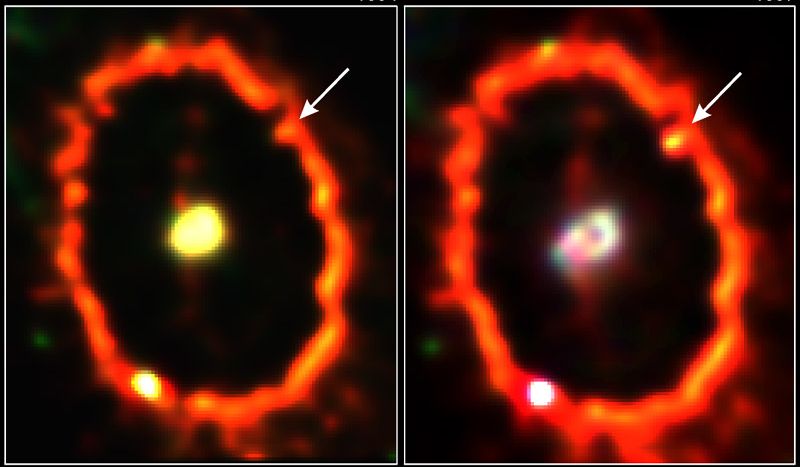Credit & Copyright: P. Garnavich (Harvard CfA)
et al.,
NASA
Explanation:
Fifteen years ago today, the
brightest supernova of modern times
was sighted.
Over time,
astronomers have watched and waited for
the expanding debris from this tremendous stellar
explosion to crash into
previously expelled material.
A clear result of such a collision is demonstrated above
in two frames
recorded by the Hubble Space Telescope in 1994 (left)
and 1997(right).
While the central concentration of
stellar
debris has clearly evolved over this period,
the yellow spot on the ring in the righthand
picture announces the collision of an outward
moving
blast wave with the pre-existing, light-year wide ring.
The collision is occurring at speeds near
60 million kilometers per hour and shock-heats the
ring material causing it to glow.
Astronomers are hopeful that such collisions will
illuminate the interesting past of
SN 1987A, and perhaps provide more clues
about the origin of the mysterious rings.
1999 2000 2001 2002 2003 2004 2005 2006 2007 2008 2009 2010 2011 2012 2013 2014 2015 2016 2017 2018 2019 2020 2021 2022 2023 2024 2025 |
Yanvar' Fevral' Mart Aprel' Mai Iyun' Iyul' Avgust Sentyabr' Oktyabr' Noyabr' Dekabr' |
NASA Web Site Statements, Warnings, and Disclaimers
NASA Official: Jay Norris. Specific rights apply.
A service of: LHEA at NASA / GSFC
& Michigan Tech. U.
|
Publikacii s klyuchevymi slovami:
supernova - SN 1987a - Sverhnovye
Publikacii so slovami: supernova - SN 1987a - Sverhnovye | |
Sm. takzhe:
Vse publikacii na tu zhe temu >> | |
